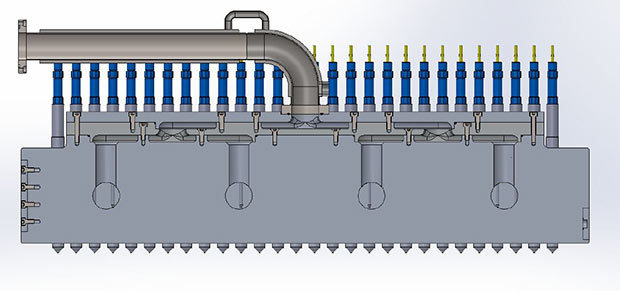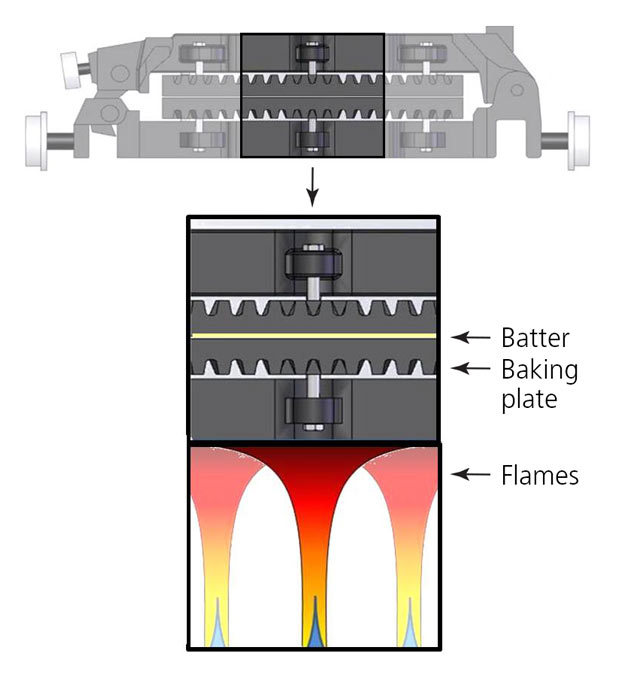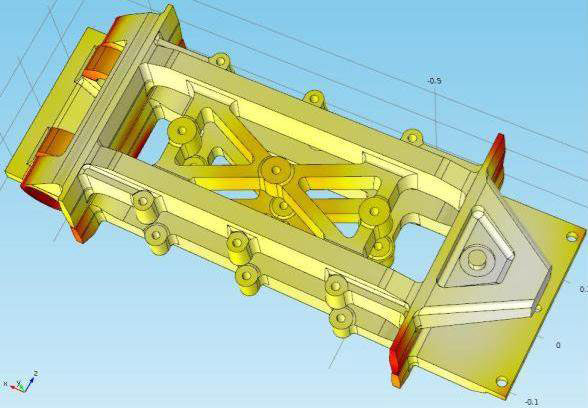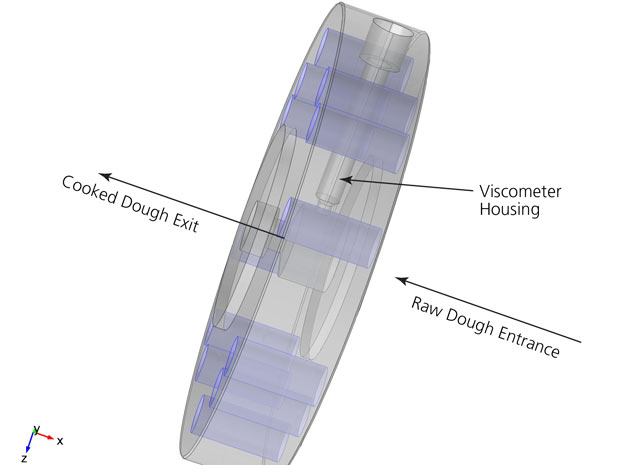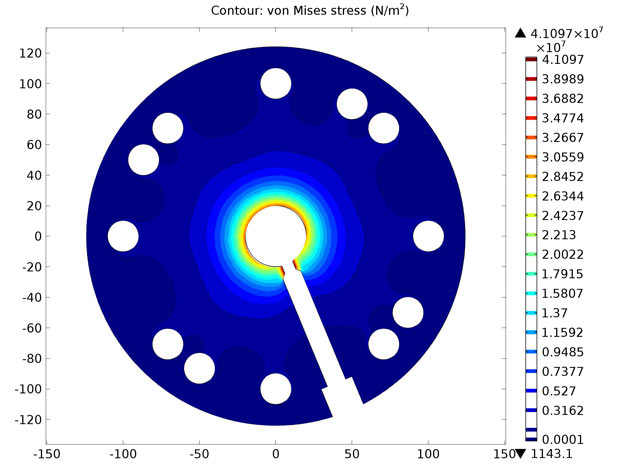
Latest News
January 18, 2016
Engineers at Nestlé’s Product Technology Centre in York, U.K., (PTC York) work, among other things, on the research and development of three different products: a chocolate depositor for making candy bars; a wafer baking plate; and an extruder, used to cook and sort cereals at the same time. At PTC York, which is home to the research and development of Nestlé’s confectionery products, engineers rely on multiphysics simulation to optimize and streamline the production process.
Chocolate R&D
Candy bars, such as Kit Kat, Aero, Crunch and solid milk chocolate bars are produced using a chocolate depositor that fills a mold with molten chocolate. Chocolate enters the depositor via an arm at the top and exits into a mold through each of the nozzle tips (see Fig. 1).
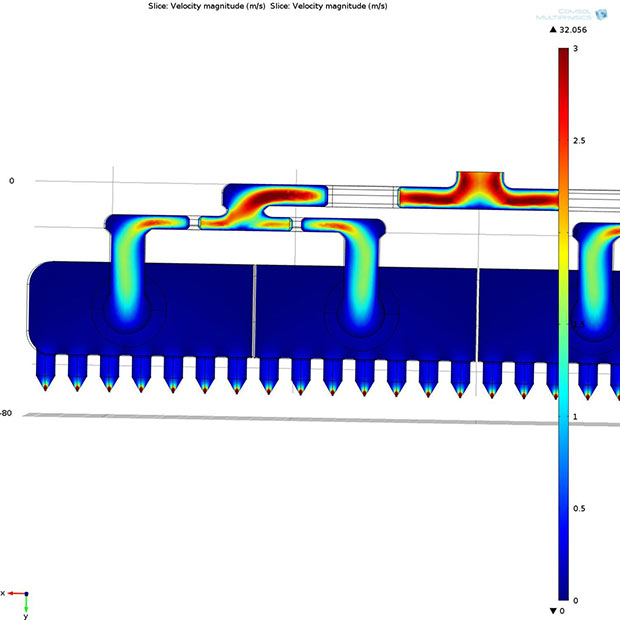 Figure 1. Top: SOLIDWORKS software geometry of the depositor. Bottom: COMSOL Multiphysics simulation showing the magnitude of chocolate flow in the depositor’s nozzles and flow channels. Images courtesy of Nestlé.
Figure 1. Top: SOLIDWORKS software geometry of the depositor. Bottom: COMSOL Multiphysics simulation showing the magnitude of chocolate flow in the depositor’s nozzles and flow channels. Images courtesy of Nestlé.“Ensuring that the amount of chocolate in every bar is consistent means that the flow rate and pressure of the chocolate exiting each nozzle must be the same,” says William Pickles, a process engineer at Nestlé. “Not only do we need to make sure that each chocolate bar is the same weight for cost effectiveness and standardization, but we are also committed to guaranteeing that the calorie information on the package is correct as well. This allows us to deliver products with exact nutritional content that fit in with our customers' balanced diets.”
In order to achieve this standardization, the uniformity in flow and pressure between each nozzle tip must be precise to within a narrow margin. To achieve this consistency, Nestlé uses a combination of modeling and simulation tools.
The chocolate depositor shown in Fig. 1 was first designed using SOLIDWORKS software and the geometry was then imported into the COMSOL Multiphysics simulation software for analysis. Simulation was used to perform fluid flow optimization, test mechanical stress and analyze the thermal properties for a particular geometry.
“Every chocolate manufacturer has their own special recipe that produces chocolate with unique characteristics,” says Pickles. “We were able to fully model the non-Newtonian behavior of Nestlé’s signature chocolate by setting up a simulation where an experimental curve relating the shear rate to the shear stress of the fluid was imported into the software. This way, we were sure that we were modeling chocolate with the same fluid properties as the real product.”
Using simulation, the team identified areas of high and low flow rates and determined the differences in flow between each of the depositor needles. Numerical probes in the flow channels and at the tips of the nozzles were used to analyze conditions at certain locations of the geometry.
“By optimizing the depositor design, we were able to achieve a flow rate through each of the nozzles that is consistent to within a tenth of a percent of the desired value,” says Pickles. These results of this simulation are shown in Fig. 2.
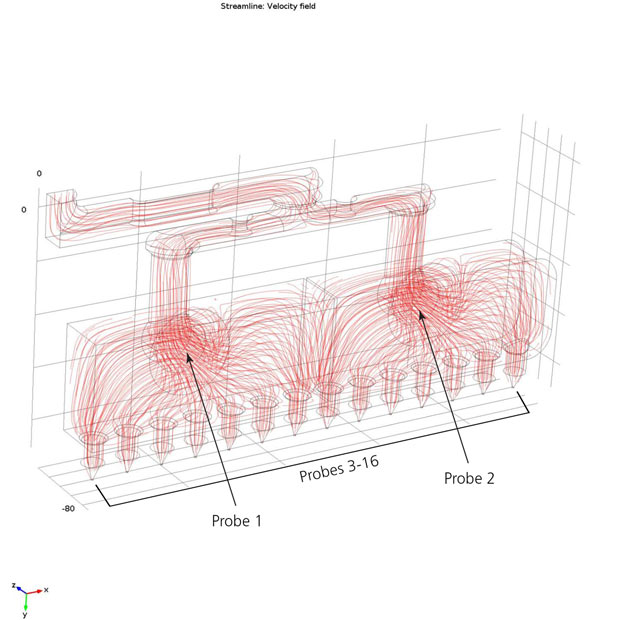 Figure 2. Probes located at each of the nozzle tips and in the flow channels demonstrate that the chocolate flow rate and pressure within the depositor and nozzles vary within specifications. Streamlines show the direction of chocolate flow.
Figure 2. Probes located at each of the nozzle tips and in the flow channels demonstrate that the chocolate flow rate and pressure within the depositor and nozzles vary within specifications. Streamlines show the direction of chocolate flow.
Simulation Saves the Crunch
What would a Kit Kat be without the well-known snap of the wafer baked inside? When baking a wafer, uneven heating can cause different moisture concentrations within the wafer, ruining its crunchy texture or even causing it to spontaneously snap.
The wafer baking process at Nestlé uses two baking plates that compress the batter between them (see Fig. 3). During baking, the plates are passed above a series of about 40 flames.
Simulation is used to optimize the baking plate design by looking at the flow of hot air below and around the plates to ensure that there is an even temperature profile across the plates' surfaces. The goal is to correct burner power and orientations to give the best wafer, while simultaneously reducing the amount of fuel used. This fits with Nestlé’s policy of continually seeking to improve efficiency in all of its manufacturing processes.
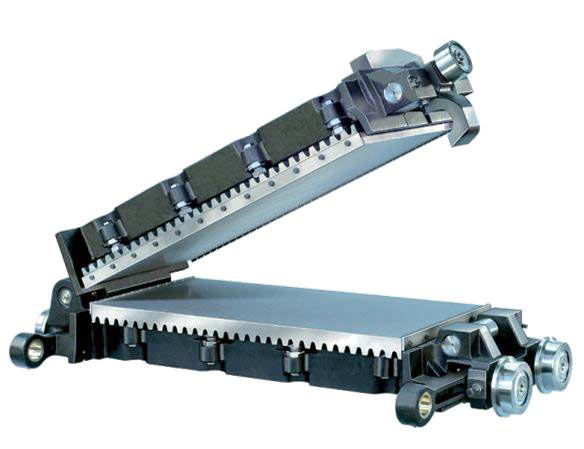 Figure 3. Two wafer-baking plates are used to bake Kit Kat wafers. The top and bottom plates compress the batter, while the flame underneath the plates bakes the wafer. Image courtesy of Nestlé.
Figure 3. Two wafer-baking plates are used to bake Kit Kat wafers. The top and bottom plates compress the batter, while the flame underneath the plates bakes the wafer. Image courtesy of Nestlé.The flames underneath the baking plates were modeled as jets of hot air, where heating proceeds via convection. Fig. 4 shows the profile of the flame underneath the baking plate and the airflow around the plate.
They were able to validate the model against baking plates used in experiments, and found that the simulation results were in very good agreement. The results also showed how warmer spots occur due to increased heat conduction through the bolts holding the baking plates together (see Fig. 5).
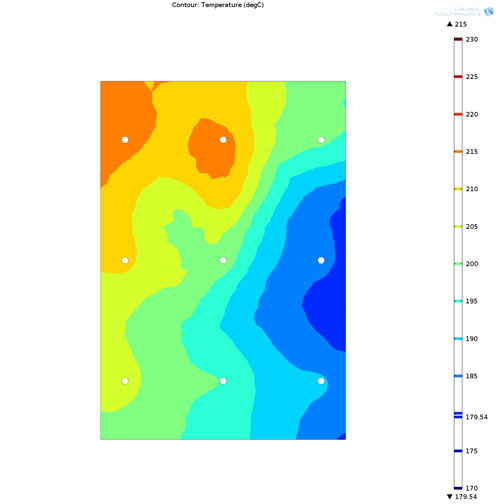 Figure 5. Top: Temperature distribution in the baking plates’ supporting frame. Bottom: Temperature profile at the surface of the top baking plate, where warmer spots can be seen at the location of the bolts (white circles).
Figure 5. Top: Temperature distribution in the baking plates’ supporting frame. Bottom: Temperature profile at the surface of the top baking plate, where warmer spots can be seen at the location of the bolts (white circles).The next step will be to optimize this design to distribute the heat as evenly as possible across the top of the plate and minimize temperature peaks.
Cooking While Extruding
Cereals such as Cheerios, Trix, Nesquik and many others are made at Nestlé using an extruder. “The high-temperature extruder used at Nestlé to make certain types of cereals works by forcing dough through a die. The pressure and friction created during this process causes the dough to cook through viscous heating,” says Pickles, referring to the extruder shown in Fig. 6. “Extruders are common because they are a compact, cost-effective way of manufacturing products.”
Pickles is working on designing the housing for a viscometer that can be placed within the extruder to measure the viscosity of the dough entering the die. This will ensure consistent quality of the dough so that it will cook in a predictable manner.
“For our design, we needed to make sure that the viscometer housing could withstand the high pressure within the device,” said Pickles.
In the original extruder design, the pressure was too high for the viscometer housing to withstand.
They redesigned the housing, which helped to reduce the pressure. They were then able to make sure that the die design didn’t exceed the yield stress so that the viscometer could safely be housed inside it. Additionally, simulation was used to check that the displacement of the extruder was consistent, as varying displacement of the device would cause the cereal being produced to have uneven shapes and sizes (see Fig. 7).
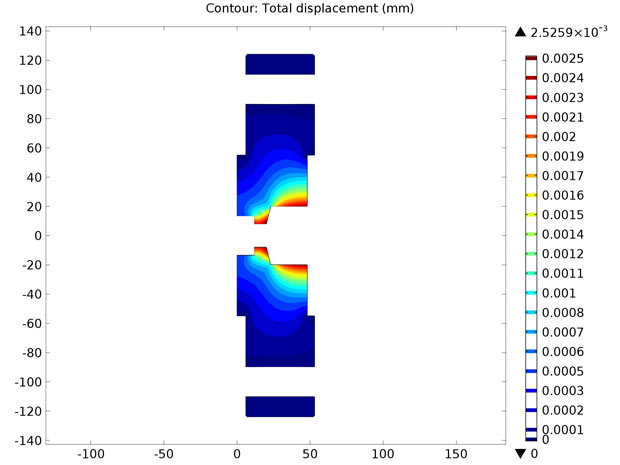 Figure 7. Viscometer housing and die simulation results. Top: Contour of von Mises stress. Bottom: Slice plot of the total displacement.
Figure 7. Viscometer housing and die simulation results. Top: Contour of von Mises stress. Bottom: Slice plot of the total displacement.
Better, Safer Products with Multiphysics Simulation
At Nestlé, simulation is a big part of the design process, from producing chocolate to wafers to cereals and everything in between.
“Since Nestlé products are going to be consumed by our customers, we need to be able to ensure that our designs will hold up in the real world,” says Pickles. “We are confident in the results obtained from our simulations, and we know that they can be trusted to help us produce the best and safest designs possible. This in turn allows us to consistently deliver tastier and healthier products.”
Subscribe to our FREE magazine, FREE email newsletters or both!
Latest News







